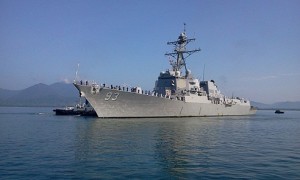
AMID renewed tensions in the disputed South China Sea, the Philippine military is batting to revive the concept of an anti-communist collective defense of Southeast Asia to enable the country to enter into a leasing arrangement of patrol boats with the United States.
An operational lease would allow the Philippine Navy to use newer U.S. ships, Navy Vice Commander Rear Admiral Orwen Cortez told a press conference following the opening ceremony of the PH-US Cooperation Afloat Readiness and Training (CARAT) in Puerto Princesa on Tuesday.
“We have experience with this during the Southeast Asia Treaty Organization (SEATO) way back in the ‘50s when U.S. ships came to the Philippines, so that was the background and we’re trying to revive that concept,” he said.
SEATO was a regional alliance formed in 1955 to contain the powers of communist China by providing for the collective defense of its members. But it only had two Southeast Asian members, Philippines and Thailand, and the latter hosted the headquarters. The other members were Australia, France, New Zealand, Pakistan, the United Kingdom and the U.S.
SEATO formally disbanded in 1977. A decade earlier, the Association of Southeast Asian Nations was established.
Recently, the Department of Energy requested the military to provide modern ships to assist oil exploration activities in the West Philippine Sea after a DOE-commissioned seismic vessel was harassed by a Chinese Navy vessel in March. (The Philippines now refers to South China Sea as West Philippine Sea.)
“We wanted to push through with the operational lease because through that concept we will be able to get newer ships rather than go to the defense articles where the ships are quite old,” Cortez said.
A military source explained that the government could not purchase patrol boats off-the-rack, and would have to wait two years to procure them, given government procurement rules.
The military briefed Foreign Secretary Alberto Del Rosario about its proposal before he left recently for a series of meetings in the U.S.
Del Rosario, in turn, tossed the proposal to the U.S. during the trip, which sought “clarification” of America’s commitment under its 60-year-old Mutual Defense Treaty with the Philippines and solicited a U.S. statement related to the oil-rich area in the South China Sea that the country is contesting with China.
But should the country enter into a lease with the U.S. that would include American military personnel who will help operate the vessels, the arrangement might violate the Constitutional ban on foreign military troops.
Article 18, Section 25 provides, “After the expiration in 1991 of the Agreement between the Republic of the Philippines and the United States of America concerning Military Bases, foreign military bases, troops, or facilities shall not be allowed in the Philippines except under a treaty duly concurred in by the Senate and, when Congress so requires, ratified by a majority of the votes cast by the people in a national referendum held for that purpose, and recognized as a treaty by the other contracting state.”

The Philippine Navy is looking at cyclone class vessels, of which the U.S. has a number. These have been mothballed but have proved useful in the Philippine setting and maritime environment.
The government’s lone cyclone class vessel is PS-38 or BRP Gen. Mariano Alvarez, also known as “BRP GMA,” said to be the favorite of former President Gloria Arroyo. It is relatively new and the country’s only high-tech patrol craft.
The U.S., however, does not lease its patrol craft, U.S. Navy Task Force Commander Rear Admiral Tom Carney told a reporter who asked about the leasing arrangement after the Puerto Princesa press conference.
“It’s only either we sell and you buy or you acquire from our grant or aid,” he said.
Recent incidents in the disputed cluster of isles in the South China Sea have again illuminated the China threat.
Besides the harassment of the DOE-commissioned seismic vessel in March, the incidents include firing of warning shots to ward off Filipino fishing boats at the Jackson Atoll in February and the unloading of markers, buoys and construction materials in the unoccupied Amy Douglas and Boxall Reefs within the 200-nautical mile exclusive economic zone of the Philippines.
But a U.S. Navy official said he views the military buildup and capability development of China not so much a concern unless these are used in a “threatening” way.
“We don’t look at specifically the current capabilities as they develop, we welcome them. We just hope that as any navy that they (China) take those capabilities and they operate with them in a very productive and transparent manner,” said U.S. Navy’s 7th Fleet Commander Vice Admiral Scott Van Buskirk.
Buskirk was in the country to formally open this year’s CARAT. The naval exercises kicked off on Tuesday in Puerto Princesa with about 800 U.S. Navy personnel and their 457 Philippine counterparts who will participate in more than a hundred military exercises, trainings and activities for 11 days.
Two missile-guided destroyers from the US, the USS Howard and USS Chung-Hoon, are complemented by two patrol boats from the Philippines, BRP Pangasinan (PS-31) and BRP Rizal (PS-74).
At a time when tension is running high in the South China Sea, the military drill is seen as a veiled warning against China’s aggression.
But Cortez said CARAT has nothing to do with the issue in the Spratlys. He said this was planned long before the issue or the tension in the Spratlys resurfaced.
While the Philippine Navy delinked the drill from tensions in the South China Sea, it invited to the opening ceremony the mayor of Kalayaan town, the group of Philippine-claimed and held islands in the South China Sea. Mayor Eugenio Bito-onon was the lone mayor present in the event.
But the Philippine Navy admitted it took into account China’s possible reaction when it decided against setting the sea phase of the exercises at the South China Sea.
Conducting it in the area might might be an irritant to the Chinese and the other claimants, Cortez said.
While the exercises will not be held in the South China Sea, the U.S. aircraft carrier George Washington was traversing South China Sea as the exercises began in Palawan. Also the anti-submarine helicopter of the USS Howard has done an overflight at the South China Sea for its routine Maritime Intelligence Surveillance Reconnaissance (MISR) en route to Palawan.
“The way we operate should not be viewed as a statement or a threat but a continuing demonstration of the commitment of our two nations to work together to improve our capabilities of operating together and to learn from each other,” Buskirk said



